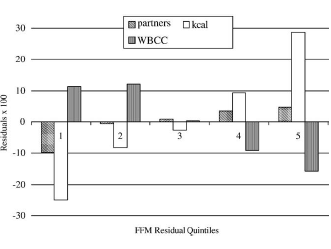|
Definition: "An ergogenic aid is any substance or phenomenon that enhances performance "
|
|
||||||||
22.06.2009 |
|
|
Muscles aren't everything for men
Let's start with some figures. Men have 60 percent more muscle mass than women. The difference in muscularity between men and women is most pronounced in the upper body. Men have 75 percent more muscles in their arms than women and 90 percent more strength in their upper body. Men have 50 percent more muscle mass in their legs and their muscular power in their lower body is 65 percent greater.
Biological research has also shown that muscles go together with testosterone, and testosterone is not a particularly healthy hormone. Nearly all male animals live longer without testes. This is because testosterone sabotages the immune system and makes the body more susceptible to infectious diseases. Muscular men make less C-reactive protein, for example, a protein made by fat cells and the liver, which attaches itself to bad microorganisms. This is how immune cells know which cells they have to get rid of. In the US your risk of dying from an infectious disease is 42 percent higher if you are a man than if you are a women.
So from the point of view of evolution, muscles have advantages and disadvantages. You're more likely to be able to pass on your genes as women are more likely to find you worthwhile, but chances are you'll die sooner.
That might explain why, according to some psychological studies, women may be attracted to muscular men, but are not so interested in them when it comes to serious relationships. [Pers Soc Psychol Bull. 2007 Aug;33(8):1167-83.] Maybe women know subconsciously that men with high levels of testosterone are less likely to live to a ripe age.
Well, so much for the theory. The researchers decided to see if they could prove it using data gathered in the National Health and Nutrition Examination Survey. For this, nearly six thousand men were monitored for six years. The graph below – for the experts, it's based on the residuals from a regression – shows what emerged from the survey.
The researchers divided the men into five equal groups [quintiles], based on their muscle mass. The men with the least muscle mass are represented on the left of the graph, those with most muscle at the far right.
Then the researchers looked at the amount of energy the men used, the number of sexual partners they had and the number of immune cells in their blood [WBCC] The amount of energy was corrected for the amount of energy the men needed to maintain their musculature.
According to the researchers, there is a trade off: the advantages that the muscular men have due to passing on their genes are counterbalanced by disadvantages. "There is a range of muscularity levels that produce equal net fitness effects with different contributions from fertility and survival, thus potentially explaining genetic variance in male muscularity."
Source:
|
|


